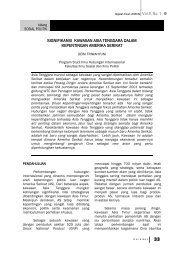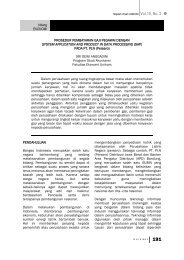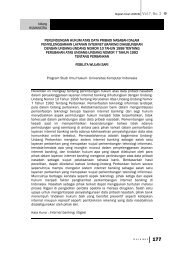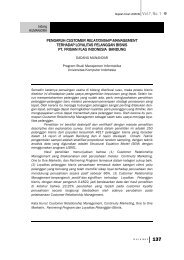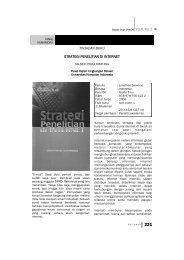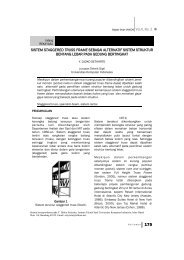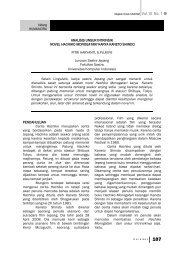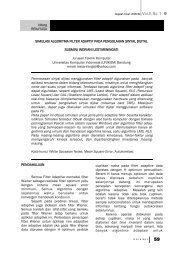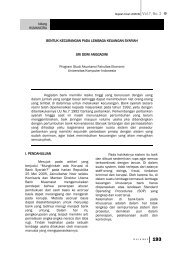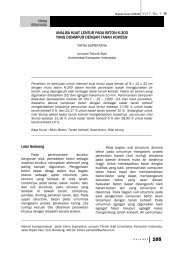LIFE CYCLE ANALYSIS (LCA) - Majalah Ilmiah Unikom
LIFE CYCLE ANALYSIS (LCA) - Majalah Ilmiah Unikom
LIFE CYCLE ANALYSIS (LCA) - Majalah Ilmiah Unikom
You also want an ePaper? Increase the reach of your titles
YUMPU automatically turns print PDFs into web optimized ePapers that Google loves.
<strong>Majalah</strong> <strong>Ilmiah</strong> UNIKOM Vol.7, No. 2bidangREKAYASA<strong>LIFE</strong> <strong>CYCLE</strong> <strong>ANALYSIS</strong> (<strong>LCA</strong>)FOR SUSTAINABLE ARCHITECTUREWANITA SUBADRA ABIOSODepartment of ArchitectureEngineering and Computer Science FacultyUniversitas Komputer IndonesiaLife Cycle Analysis (<strong>LCA</strong>), a kind of cradle–to–grave paradigm based instrumentfor measuring the product sustainability by analyzing energy, cost, and environmentalimpacts that would be spent and occur along the product–life–cycle, isone of mechanisms used for Eco Labeling or Environmental Labeling, certificationsof acknowledgement on sustainable product.The labeling could possibly be carried out by way of kind of <strong>LCA</strong> instrument limitedwithin economically established countries. What about sustainable architecture,that would always be involving energy, cost, and environmental impacts aswell, as all we know architecture cannot separated from building in terms ofbuilding as a product of architecture.“System Approach to Architecture”, offered by A. Benjamin Handler, simplifiedto considering architecture as a system practically based on paradigm that similarto <strong>LCA</strong>. System that consists of designing process, construction, facility operation,and human bionomic process, will act as a building–life–cycle instrumentif at the end of the system completed with a building management systemor a system that concern about end of life of the building, such as recycling process,renovation, or preservation. TowardKey Words: sustainable product, product–life–cycle, Life Cycle Analysis (<strong>LCA</strong>),cradle–to–grave, architectural system, building–life–cycle, Sustainable Architecture<strong>LIFE</strong> <strong>CYCLE</strong> <strong>ANALYSIS</strong> (<strong>LCA</strong>)A WAY TOWARDSUSTAINABLE PRODUCTLife Cycle Analysis (<strong>LCA</strong>), a kind of instrumentbased on cradle–to–grave paradigmfor measuring product sustainability byanalyzing the product–life–cycle, whichmeans along its life cycle a product shouldbe using either renewable or non–renewable resources in a very sensibleway. <strong>LCA</strong>, also a popular term for whoconcern about environmental issues, indifferent phrase an instrument for improvingproduction process and its productwith the purpose of minimizing environmentalimpacts particularly energyand cost that would be spent along theprocess, with the intention of logicallymanage for effectiveness.H a l a m a n199
<strong>Majalah</strong> <strong>Ilmiah</strong> UNIKOM Vol.7, No. 2Wanita Subadra AbiosoIn broader terms, <strong>LCA</strong> is an instrument forevaluating environmental attributes associatedwith product, process, and service.The evaluation will be implemented overimpacts that will occur along the cradle–to–grave or from birth until death or from a–to–z of product–life–cycle specifically fromraw materials extraction until waste disposalmanagement.Since the first present in 1960 until early1990, <strong>LCA</strong> was not extensively applied, butsince then has been developed somemethodologies, which is broadly acceptedand the application of <strong>LCA</strong> progress increasinglyand got some acknowledgementsfrom international standards suchas ISO 14040–14043. In 1993, ISOformed Technical Committee (TC) 207 toestablish ISO 14000 as environmentalmanagement standards that consists ofsix (6) environmental issues: 1The first three (3) issues concerning aboutvaluation on organization: Environmental Management System(EMS) is certification process for ISO14001. Environmental Auditing (EA) is certificationprocess for ISO 14010–12. Environmental Performance Evaluation(EPE) is certification process forISO 14031.The second three (3) issues concerningabout valuation standards on products: Environmental Labeling (EL) is certificationprocess for ISO 14020–24. Life Cycle Analysis (<strong>LCA</strong>) is certificationprocess for ISO 14040–43. Environmental Aspects in ProductStandards (EAPS).—————————————————1 SOCMÆs ISO 14000 OverviewAs an evaluation instrument, <strong>LCA</strong> hassome prime features that have been appliedsince 1970. Besides used as anevaluation tool on conceptual process andquantitative evaluation, it can be used tocreate a consistent process in global scalethroughout its three basic components:1. Inventory of Effects2. Impact Analysis3. Improvement AnalysisIn the very near future, manufacturershould include estimation on productionprocesses of service, goods, and wastemanagement under their responsibilities,and not consider them in a second placeor second thought. Hence, it is needed topay much more attention to product–life–cycle that means not only concern aboutthe product creation and materials usagebut also concern about what will happenat the end of product life. Currently, theengineers have included design for disassembly,design for recycling, and designfor environment into their responsibilities,which is counting environmental aspectsinto their design vocabulary.CRADLE–TO–GRAVE PARADIGMPRODUCT–<strong>LIFE</strong>–<strong>CYCLE</strong>“50% of energy consumption of built environmentrepresented relationship withconstruction industry 2 ”, construction industryincluding architecture in regard withbuilding is a part of secondary industry,which always relate with energy producing.The above statement forwarded by membersof AIA (American Institute of Architects)and IUA (International Union of Architects)when proposed addendum onAgenda 21 3 , proceedings of The 1992 RioEarth Summit, Rio de Janeiro, Brazil, which—————————————————-2 Steele, James (1997), Sustainable Architecture,Principles, Paradigms, and Case Studies, McGraw–Hill, New York, page 16.3 Ibid. page 8H a l a m a n200
<strong>Majalah</strong> <strong>Ilmiah</strong> UNIKOM Vol.7, No. 2consists of comprehensive scope outlineof Sustainable Development. Addendumitself comprise of their concerns aboutextensive usage of non–renewable resources,mainly fossil fuel energy resource.The 1973 United States of America(USA) oil crisis might be triggered bypolitical issue, to be precise conflict betweenArab, Egypt, and Syria as oil producercountries with Israel, accordingly oilembargo executed to all Israel adherentcountries including USA. Aside from politicalissues, in fact there is declining ofavailability of world fossil fuel energy resourcemoreover if usage was not sensiblyconsidered. Energy global phenomenon asconsequence of extensive usage of fossilfuel energy has forced us including architecturecommunity to take a place to beconcerning, if we do not want to face morehard economic depression.Besides producing energy for modern vehicles,heating, and other household activities,fossil fuel particularly oil and naturalgas producing energy for industrial andagricultural products as well such as fertilizer,pesticides and plastics. It means, thatis not dreadfully easy for replacing oil andgas with other fuels or with food supply,therefore without sufficient energy supplywe will lose agricultural capacity. If fossilfuel price raise, it will be followed by priceraise of fertilizer and pesticide into muchmore expensive one, furthermore thesituation will stop farmers using suchgoods. "Yields will go down and the price offood will go up and that in turn is perceivedas quite an economic hardship 4 ".—————————————————--4 Amos, Jonathan, Energy Crisis 'will limit births', BBCNews Online science staff, in Seattle, http://news.bbc.co.uk/1/hi/sci/tech/3465745.stm.5 Van der Ryn, Sim, and Peter Calthorpe (1986),Sustainable Communities, A New Design Synthesisfor Cities, Suburbs, and Towns, San Francisco:Sierra Club Books, page iv.Sustainable development as second waveof sustainability 5 is a concept that hasstrength on integrity between social, economic,and environmental systems.Sustainable development has purpose forencouraging people to create a better wayof life, to be precise can describe as networkof activities that using renewable ornon–renewable resources particularly energyin a sensibly way therefore will notmake future generation worry about sustainableavailability of the resources. Sustainabledevelopment clearly offers problemsolving for the degradation of environmentalquality and escalating of povertybut still restricted yet. Explicitly only withineconomically established countries environmentallabeling or eco labeling couldbe carried out. Environmental labeling oreco labeling is certification of acknowledgmentfrom Organization of InternationalStandards (ISO) 14000 on sustainableproduct through Life Cycle Analysis (<strong>LCA</strong>)mechanism, by means of evaluating energy,cost, and other environmental impactsthat will be spent and occur along itsproduct–life–cycle.Biosphere, the whole earth surfaces includingatmosphere and ocean that inhabitedby human being and other live creaturesrepresenting material goods resourcesand capitals to be exploited forsupporting human being and other livecreatures life. For that reason, it is neededhighly concerns about product–life–cycle,which always relate with energy producingin regard with maintain them. Product–life–cycle principles can be studied on Figure–1: The Product Life Cycle Principle. Raw Materials: 1. Use materials withless environmental impact; 2. Use lessmaterial; Manufacture: 3. Use fewer resources;4. Produce less pollution and waste; 5.Reduce impact of distribution; Use: 6. Use fewer resources; 7. Cause less pollution andwaste; 8. Optimize functionality andservice life. End–of–life: 9. Reduce the environ-H a l a m a n201
<strong>Majalah</strong> <strong>Ilmiah</strong> UNIKOM Vol.7, No. 2Wanita Subadra AbiosoFigure–1: The Product Life Cycle Principle.Source: http://www.weeeman.org/html/what/lifecycle.htmlmental impact of disposal; 10. Make re–use and recycling easier.BUILDING–<strong>LIFE</strong>–<strong>CYCLE</strong>Figure–2 below can give an explanationabout environmental impacts, which willoccur as consequences of building–life–cycle as follow: Cradle (i.e. Birth): Raw material accusationwill cause energy and cost usagebesides environmental impact. Products manufacture transportation:idem ditto Construction and fitting out: idem ditto Operation and maintenance: will causeoperating energy and cost usage besidesenvironmental impact as well. Grave: Renovation and demolition willcause energy and cost usage besidesenvironmental impact.To estimate the amount of energy that willbe used, there should be analysis on bothenergy, which is integrated into buildingand consumed along its life or for operationaland maintenance purpose. Operationwill depend on material usage andfabrication methods, meanwhile maintenancewill depend on orientation, zone,and kind of windows, building surface sophistication,and will depend on lightingand air conditioning system, insulation,thermal characteristics of wall and roof.H a l a m a n202
<strong>Majalah</strong> <strong>Ilmiah</strong> UNIKOM Vol.7, No. 2Figure–2: Building–life–cycleSource: http://www.emsd.gov.hk/emsd/eng/pee/lceabc.shtmlA house which using brick cladding on concreteslab and steel sheet on steel roofframe will need fewer energy compare tousage of energy along its life, since almostenergy will be consumed for lighting, refrigerating,and/ or heating systems.The most effective way to reduce a householdlife cycle is by using energy conservedmaterials and system, which is neededalong the operational process. Solar passivedesign principles along with energyconserved tools and lighting system is thekey factor with the intention of reducesenergy consumption, which produced CO2as well as consequences of the increasingof energy production.SYSTEM APPROACH TO ARCHITECTURE AWAY TO SUSTAINABLE ARCHITECTUREAs an instrument for environmental managementand decision making on productionprocesses, <strong>LCA</strong> denotatively showedthe relationship with global recovery, howeverin regard with entire network howarchitecture will be related.“System Approach To Architecture” simplifiedto “considering architecture as a system”offered by A. Benjamin Handler(Handler, 1970), that consists of four subsystems: 1. Design Process; 2. ConstructionProcess; 3. Operational Process; 4.Human Bionomic Process, practically hassimilar paradigm with <strong>LCA</strong> in regard withsolving architectural problems.The entire processes carried out by thefour sub systems showed that architecturalsystem keep considering the life cycleof its product in this case the building–life–cycle, though has not included thelast process that will manage the buildingat the end of its life. The later process canbe analogized with waste management of<strong>LCA</strong>.However, Handler explicitly has not statedenvironmental impacts yet particularly asresult of consumption of energy and costH a l a m a n203
<strong>Majalah</strong> <strong>Ilmiah</strong> UNIKOM Vol.7, No. 2Wanita Subadra Abiosothat would be spent along with building–life–cycle in context building as product ofarchitectural system or process, but implicitlyHandler suggests that architecturalproblems should be accomplished basedon a cradle–to–grave paradigm.Within system of architecture, the architectsmight be merely interested with planningand designing building process. Infact, they cannot avoid involvement of constructionofficers, building operators, andbuilding users, along the production of thebuilding until the end of life of the building.Therefore, building–life–cycle evaluationcan be carried out by system of architecture,which can be analogized with <strong>LCA</strong> asan instrument inherent in system of architecture.Throughout “Sustainable Architecture”,James Steele forwarded his considerationabout role of architects, environmentaleconomy, material, even study on sustainablearchitecture: The role of architects to reach sustainablebuilding or architecture instead ofsustainable product, represented byenergy conserved designs, usage ofrelevant literature, applying traditionalwisdom, not regarding land as commodity,and responsive towards environment. Environmental economy substanceoffered by suggesting estimating life–cycle–costing. Materials that should be aware of thatare extensively used all over the worldfor instance aluminum, concrete, plywood,and steel. To be precise energyintensive materials are materials thatare produced by using a very largeamount of energy. Curriculum applied should be anticipativeto previous curriculum that hasapplied value and norm which judgednature as enemy to be conquered, andnot consider them as basis for life andenvironment as a place where architecturecan and have to harmoniously fitin.Similar consideration advanced by Brendaand Robert Vale throughout their “GreenArchitecture”: “Architectural paradigm haschanged”, this statement forwarded sincethere is tend to changes towards designsof energy conserved, working with climate,minimizes usage of new resources, respectingusers, respecting site, and holism.In the course of “Designing with Nature”,Ken Yeang offering architectural designconcept by way of ecological approach.The approach including analysis, synthesis,and evaluation stages, which is basedon “Value in Building” theory from T. Markusin 1973. On evaluation stage, Yeanghas more taken notice to life cycle of everystep of evaluation criteria to be preciseproduction process, construction, consumption,and recovery process. On thosestages Yeang considered architecturaldesign as cyclic system as “from source tosink” that similar to cradle–to–grave thatis starting from resource extraction endedat the unvalued condition.Based on stated considerations, it can beconcluded that regarding architecture as asystem means keep concerning aboutbuilding–life–cycle in context of buildingas product of system of architecture. However,considering architecture as a systemis the right step for architecture to takeplace in responsibilities upon the decreasingof natural resources mainly non–renewable energy resources.PROJECTION IN INDONESIAThere must be many Indonesian architecturaltheorists and practitioners who havehad similar thought and commitment evenhave been applying the design criteria,which is formulated based on cradle–to–grave paradigm though explicitly has notshowed yet the estimation of building–life–cycle using sort of instrument such as<strong>LCA</strong>.However, merely commitment could beH a l a m a n204
<strong>Majalah</strong> <strong>Ilmiah</strong> UNIKOM Vol.7, No. 2less worked if it is not supported by politicalwill or government commitment. Althoughonly economically establishedcountry can be carrying out certificationprocess such as eco labeling ISO 14041–14043 by way of sort of instrument suchas <strong>LCA</strong>. Nevertheless as part of global architecturalcommunity, Indonesia shouldbe involving themselves by minimizingenvironmental impacts as consequencesof the existences of architecture, if do notwant to be alienated.Applying tropical architecture, energy conservation,using local material, awarenessof preservation, revitalization, and renovationon designs besides create them asmanifestation of traditional wisdom, whichis expressing Indonesian architecture andarchitects involvement, intrinsically hasbeen in sustainable spirit.However, it should be better if the involvementcarried out systematically and holisticby considering building–life–cycle fromraw materials extraction until end of life ofthe building in every architectural designprocess, in context building as product ofsystem of architecture.CONCLUSIONSBy keep considering building–life–cyclewithin an architectural process, it meansthat we are constantly making up life qualityinto a better one under economic depressionthat growing harder, as consequencesof the decreasing of environmentalquality and limitation natural resourcesparticularly non–renewable energyresources.As a part of industrial construction, whichalways relate with energy producing, architecturesuppose to do something in regardwith this situation, and it has been proofedby concerns from a number of architecturaltheorists and practitioners about thestated problems.According to this discourse, there would beuneasiness for some architects. Nevertheless,we no need to worry about the matters.Concerning about the building–life–cycle within system of architecture meansanalyzing energy, cost, and other environmentalimpacts that would be spent andoccur along the building–life–cycle.However, analysis by using a cradle–to–grave based instrument such as <strong>LCA</strong> is nota paradigm shifting of strategies or architecturaldesign methods but it is more tobe parallel, side–by–side, and a complementaryprocess.Inherently, architectural planning and designingstill produce designs that are relatedto the creation of value or meaningwith the intention of arousing users‟ emotionand sensitivity.On the other hands, estimate life cycle ofthe building along an architectural processin context building as product of system ofarchitecture, offering designs that canminimize environmental impacts as consequencesof building–life–cycle, or designsthat associated with quality and reliableissues.BIBLIOGRAPHY1. Abioso, Wanita Subadra (1999), KriteriaRancangan Arsitektur Dalam KonteksPembangunan Berkelanjutan, ProgramMagister Teknik Arsitektur, ProgramPasca Sarjana, Institut TeknologiBandung.2. Amos, Jonathan, Energy crisis „will limitbirths', BBC News Online science staff,in Seattle, http://news.bbc.co.uk/1/hi/sci/tech/3465745.stm.3. Frosch, Robert (1995), The IndustrialEcology of The 21 st Century, ScientificAmerican.4. H t t p : / / w w w . c f d . r m i t . e d u . a u /Publications/papers/<strong>LCA</strong>-CR.html5. Handler, A. Benjamin (1970), SystemsApproach to Architecture, New York:American Elsevier Publishing Company,Inc.6. Holdway and Walker, (2004), Http://w w w . w e e e m a n . o r g / h t m l / w h a t /lifecycle.html7. Steele, James (1997), Sustainable Architecture,Principles, Paradigms, andH a l a m a n205
<strong>Majalah</strong> <strong>Ilmiah</strong> UNIKOM Vol.7, No. 2H a l a m a n206




